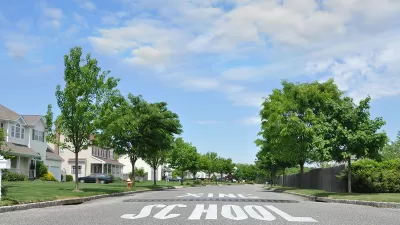A trio of journalists gathers to discuss statistics that show the trends of U.S. population growth has shifted to suburban areas.

"After years of excited talk about the comeback of America’s cities, evidence has been piling up in recent months that the suburbs are doing much better, with even those quirky-but-ubiquitous millennials now moving there in large numbers and buying SUVs," according to the premise of a recent Bloomberg View article.
That premise offers Justin Fox, Conor Sen, and Noah Smith with an opportunity to participate in a discussion about the causes and consequences of the recent resurgence of the suburbs.
The discussion touches on some familiar theories to explain the recent growth of the suburbs: 1) housing choices of the last decade (and mobility choices) were a symptom of a sluggish economy, 2) Millennials might be moving the suburbs not out of choice, but necessity (born of suburban-focused policies on transportation and development), 3) suburbs are increasingly adopting urban models of development, and 4) changes in employment and industry are driving urban growth, but urban land use policies don't allow housing construction to keep pace with job growth.
FULL STORY: Millennials Are Driving the Suburban Resurgence

Planetizen Federal Action Tracker
A weekly monitor of how Trump’s orders and actions are impacting planners and planning in America.

Restaurant Patios Were a Pandemic Win — Why Were They so Hard to Keep?
Social distancing requirements and changes in travel patterns prompted cities to pilot new uses for street and sidewalk space. Then it got complicated.

Maui's Vacation Rental Debate Turns Ugly
Verbal attacks, misinformation campaigns and fistfights plague a high-stakes debate to convert thousands of vacation rentals into long-term housing.

In California Battle of Housing vs. Environment, Housing Just Won
A new state law significantly limits the power of CEQA, an environmental review law that served as a powerful tool for blocking new development.

Boulder Eliminates Parking Minimums Citywide
Officials estimate the cost of building a single underground parking space at up to $100,000.

Orange County, Florida Adopts Largest US “Sprawl Repair” Code
The ‘Orange Code’ seeks to rectify decades of sprawl-inducing, car-oriented development.
Urban Design for Planners 1: Software Tools
This six-course series explores essential urban design concepts using open source software and equips planners with the tools they need to participate fully in the urban design process.
Planning for Universal Design
Learn the tools for implementing Universal Design in planning regulations.
Heyer Gruel & Associates PA
JM Goldson LLC
Custer County Colorado
City of Camden Redevelopment Agency
City of Astoria
Transportation Research & Education Center (TREC) at Portland State University
Camden Redevelopment Agency
City of Claremont
Municipality of Princeton (NJ)





























